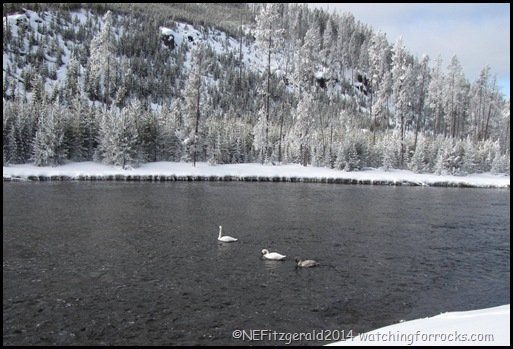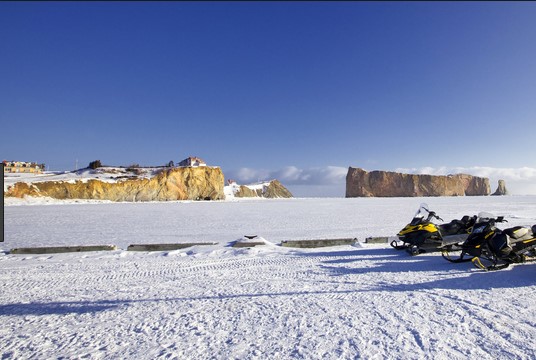During the long cold months of a northwestern Wyoming winter, roads inside Yellowstone are only groomed for over–snow vehicles. There is the occasional skier who manages to ski the entire 35 miles between West Yellowstone and Old Faithful (in one direction or the other), but I definitely do not fit into that category of altitude–crazed athlete. I have enough to do just staying upright on the bunny slope (there will be more on this later).
 |
| The Bombardier and a line of snowmobiles stop for wildlife along the Park road |
So unless you are driven by demons to come in on skis, entering the Park is either by commercial snowcoach or with a commercial guide on a snowmobile (although next winter some of these rules will have changed to accommodate different types of groups). Best Available Technology (BAT) snowmobiles are required, and there is a daily limit on snowmobile and snowcoach entries.
When I booked our snowcoach tour I chose the least expensive guide company which just turned out to have the coolest rigs – rickety, drafty, noisy relics full of north country character. Originally built in Quebec in 1939 these tracked vehicles have been used for everything from school buses to oil exploration. Bombardiers were introduced into Yellowstone in 1955 and have been here ever since. We had no problems coming in one day and leaving three days later. The tour company was very accommodating.
 |
| The Bombardier for our inbound tour |
All I really wanted was to be taken into the Park along the west side geyser basins. I figured we would see some wildlife but I didn’t really care what it was. My burning desire all along was to see Yellowstone’s thermal features in the snow.
Not far out of West Yellowstone we stopped to watch a small herd of female elk look for an early lunch along the Madison River.
 |
| Elk half in and half out of the Madison River |
We turned on to the side road to Firehole Falls, a popular swimming spot during the summer months. For some reason there was no one in the water today. Could it have been because the wooden stairway down to the river was frozen solid with ice and snow?

We bounced pleasantly along in our bright red Bombardier named Shoshone, chatting with friendly day–tripping strangers. Kay and I were the only passengers who would be staying at the Old Faithful Snow Lodge for a few days. The guide stopped often so we could pop the roof window off the snowcoach, stand up with our heads and cameras peeking out, and take advantage of whatever photo ops presented themselves.
 |
| Trumpeter swans and cygnet stay the winter in Yellowstone |
Our guide told us that a small number of trumpeter swans actually spend their winter around the Firehole River, warmed by thermal run–off from the hot springs further upstream. In the spring these swans will leave the Park and migrate north to Canada and Alaska to breed.
 |
| Trumpeter swans and cygnet at their winter home on the Firehole River |
Bison moseyed along the road at their own particular speed, getting out of the way when they were good and ready to do so.
 |
| Bison – they go wherever they please |
Evidence of red fox would keep us intrigued over the next few days, whether we were seeing the fox itself tracking something far across an expanse of snowy wilderness…
 |
| Red fox |
…or perhaps seeing it stopped to peer and wonder at the strange creatures passing by in the clattering red snowcoach…
 |
| This beauty was walking along near Black Sand Basin |
…or merely noticing its ephemeral tracks in the snow, telling of its passage as we walked the misty morning paths of the Upper Geyser Basin.
 |
| Fox tracks disappear into the Upper Geyser Basin |






